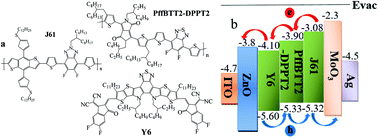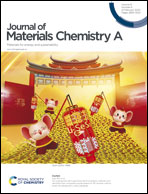Complementary light absorption and efficient exciton dissociation lead to efficient and excellent ternary polymer solar cells†
Abstract
Inverted structure ternary polymer solar cells (PSCs) are designed by blending J61 and PffBTT2-DPPT2 as the donor and Y6 as the acceptor. J61:PffBTT2-DPPT2:Y6 ternary films can replenish the weak absorption of PffBTT2-DPPT2:Y6 binary films at medium wavelengths and broaden near-infrared wavelength absorption windows. At the J61/PffBTT2-DPPT2, J61/Y6 and PffBTT2-DPPT2/Y6 triple interface, the more efficient exciton dissociation is formed in the ternary photoactive layers due to the good compatibility among J61, PffBTT2-DPPT2 and Y6. Simultaneously, effective hole transport occurs at the blend donors due to the similar highest occupied molecular orbital (HOMO) energy levels of both J61 and PffBTT2-DPPT2. Optimized ternary PSCs have a power conversion efficiency (PCE) of 13.88%, with a short-circuit current density (JSC) of 24.04 mA cm−2, an open-circuit voltage (VOC) of 0.82 V and a fill factor (FF) of 70.4%. Approximately 10.9% and 15.7% PCE improvements are obtained compared to J61:Y6 and PffBTT2-DPPT2:Y6 binary PSCs, respectively, as a result of the simultaneous increase of the JSC and the FF of the optimized ternary PSCs. The broad and weak crystallinity peak and high crystallization temperatures of the optimized ternary photoactive layer are beneficial for better thermal stability. After a thermal annealing treatment of optimized ternary PSCs at 80 °C for 20 hours, 79% of the initial PCE was observed compared with only 72% and 70% of the initial PCE for J61:Y6 and PffBTT2-DPPT2:Y6 binary PSCs, respectively, under the same thermal stress conditions.



 Please wait while we load your content...
Please wait while we load your content...